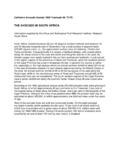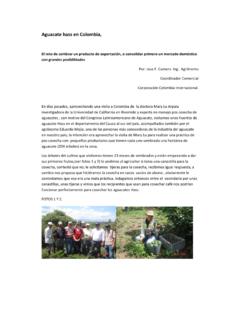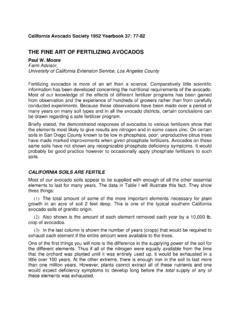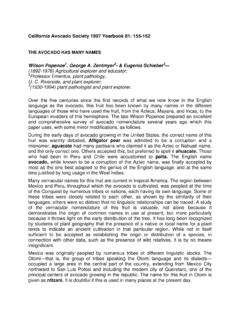Transcription of Avocados in San Diego County
1 California avocado Association 1936 Yearbook 21: 136-140. Avocados in San Diego County Jean C. Miller Assistant Farm Advisor The avocado trees on many hundreds of acres in San Diego County have reached a period when the demonstration of certain fundamental principles is apparent. Such factors as the effect of climate, water quality, soil depth and sub-drainage, cultural practices, have reached a point where the picture drawn by Nature is rather clear cut and obvious in its relation to many of the problems growers faced a few years ago. There still remain great unknown fields and time will cause a reversal of many of our present ideas of fact, but in spite of this, it is best to attempt the formation of definite conclusions even if for no other reason than to know definitely when and what changes take place in our ideas in the conduct of the industry.
2 The planting of Fuertes is recommended on a ratio of ninety to ten of summer varieties such as Nabal and Pueblas or some of the Fuerte-like summer fruits. The present price and yield of summer fruit has led to a greater planting of trees of these and other summer fruit yielding varieties which arouses some concern as to the future marketing of the summer crop. The hope is that time and marketing effort will solve the problem of the sale of California summer Avocados on the eastern markets in competition with the Florida and Cuban fruits. Such areas as Escondido, Vista, Fallbrook, La Mesa, El Cajon and similar localities having a climate not too greatly affected by the fogs of the ocean on the one side and reasonably free from drying desert winds on the other, seem to be well adapted to the requirements of the Fuerte variety from a fruit setting and tree growth standpoint.
3 Varieties having an earlier blossoming period than the Fuerte have yielded well under coastal conditions. It should be pointed out that some growers with Fuerte groves on the coast have secured good yields, thus pointing to the possibility of the need for different cultural practices in the coastal area than those found satisfactory in areas away from the coastal influence. DECOMPOSED GRANITE IDEAL. Soils three to five feet deep, of uniform texture, free from strata which limit downward, uniform movement of moisture, are producing the most satisfactory tree growth. Heavy surface soils which become lighter at depth have produced good trees. Soils of the decomposed granite type, free from sub-stratas of clay and underlain by a loose or coarse granite, appear to be ideal. Considerable difficulty is met by growers having a loose surface soil, underlaid at about eighteen to twenty-four inches with impervious stratas of clay, sandstone or other materials which cause the formation of a water table, and in turn, have a destroying effect on the root system of the tree.
4 Healthy trees may be maintained on this soil if soil moisture is managed properly. Until a grower has experienced this condition or seen his neighbor lose many of his trees because of this problem, it is very difficult to realize its full importance. It should not be necessary to mention the other general soil condition but what has happened in the past may happen again. Most of the Avocados planted on shallow, poorly sub-drained soils, were destroyed during the wet winter of 1931-32. Another such year will clear up this problem, but with it will come losses to individuals and the industry that should have been avoided. Since any individual loss is in reality a loss to the community as a whole, every effort should be made to protect new people coming into the industry by acquainting them with the hopelessness of attempting to grow avocado trees on soils not adapted to their satisfactory development.
5 Shallow and poorly sub- drained soils are to be avoided. New as well as old producers of avocado orchards might well study the U. S. Department of Agriculture Soil Survey by R. Earl Storie, especially in reference to physical factors of the soil. These may be studied at the Farm Advisor's office and at libraries. Both the blossom and the young twig are subject to damage by temperatures of 28. degrees or below and at freezing temperatures of long duration. Plantings are only recommended in areas most free from the danger of frost damage. avocado acreage is further limited to those areas supplied with an abundance of good quality water. The industry is too young to form a conclusion on how much chloride salts may be withstood successfully by an avocado tree. There are other complicating factors such as quantity of water usable from an economic as well as tree health standpoint.
6 Soil drainage, rainfall and other soil salts have yet to be determined in their proper relationship. So-called salt damage on avocado trees has been so involved with improper water management and poor sub-drainage that no definite statement on what is harmful could be made. However, waters containing two hundred parts per million or over of chlorides certainly are in the questionable brackets and should be avoided if possible. SOIL AUGER TO TEST MOISTURE. In irrigation management, the use of a soil auger to determine when and how much to irrigate can not be over-emphasized. The avocado uses more moisture than many other trees of the same age because of the great foliage development. It has been found to be most sensitive to excessive irrigation and poor sub-drainage. Most growers are aware of the poor drainage angle, but many practice more frequent applications than are best for the tree health.
7 This is a fine point and carries the great danger of allowing the tree to suffer for lack of moisture if carried to the opposite extreme. The most successful growers are most careful in just meeting the needs of the tree and at the same time not causing damage to the health and vigor of the tree. Those growers who have two or three feet of good soil underlain by a strata of impervious subsoil are most likely to appreciate this point. A study of root conditions by trenching three feet deep from the irrigation furrow to the base of the tree often exposes conditions that the grower can correct. The use of portable underhead sprinklers is rapidly being accepted and the system installed in new and old orchards of the County . This development allows contour planting on rough ground with little preparation other than clearing the brush from the land.
8 Basins are used the first two or three years, then followed by the use of sprinklers. Some provision for surface drainage of excess rainfall should be made, as well as box rows for the movement of fruit and future pest control equipment if and when needed. Experience has justified the use of nitrates in the form of five pounds of sulphate of ammonia applied to all the root area of a mature tree in December or January. The use of organic matter seems justified and this material should be applied annually in some form. There appears to be no relationship between cultivation and crop production after the trees have reached a size sufficient to shade out weed competition. The elimination of severe weed competition and weeds as a fire hazard requires cultivation or other means of elimination.
9 A two-day County avocado School was held, at which cultural practices and marketing methods were presented and discussed. April Wallace Sullivan, Economist from the University of California, explained the methods of keeping cost of production efficiency studies. Several members of the Department agreed to cooperate in a study for San Diego County . The State avocado Committee met at Los Angeles and developed a program of legislation, including that on avocado Theft Control. May Many of San Diego County growers attended the annual meeting of the California avocado Association held at Santa Ana. James G. France spoke to the Department on his travels in Cuba, Florida, Mexico and Guatemala. Judge F. D. Halm, R. F. Frantz and H. H. Gardner of Los Angeles were present as guests. A Top-Working and Cultural-Practice Demonstration was held at Calavo Gardens, near Mount Helix.
10 "Control of avocado Pests" was discussed by Dean Palmer and Cy Osborne at a meeting held in Fallbrook. June Department members were led in a discussion on Boot Stocks and Varieties by A. G. Hazzard, Chairman of the Variety Committee. July Dr. E. A. Stokdyk, of the Bank of Cooperatives, spoke on Cooperative Marketing at Vista and Carlsbad. August Carter Barrett, Chairman of the Association's Variety Committee, spoke on the "Adaptation of avocado Varieties to Various Areas," at the Department meeting held at Carlsbad. September An interesting display of avocado fruit was made at the Escondido Grape Day Fair. Methods of care were demonstrated at a meeting held at Calavo Gardens. October An avocado display was prepared at the County Fair held at Del Mar. Officers were elected at the October Department meeting, held at Del Mar during the Fair.

















